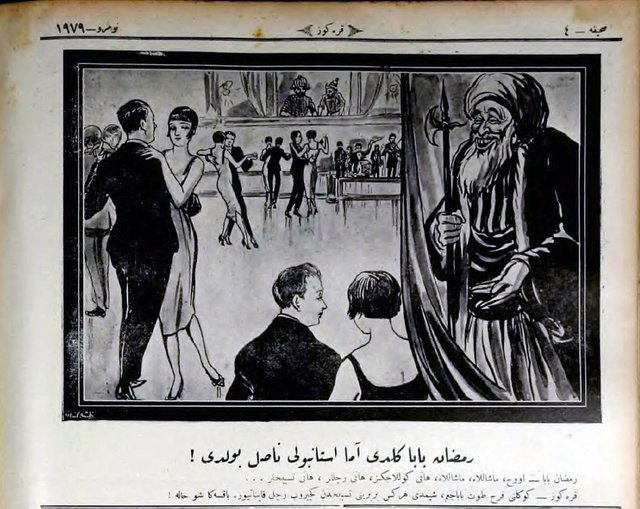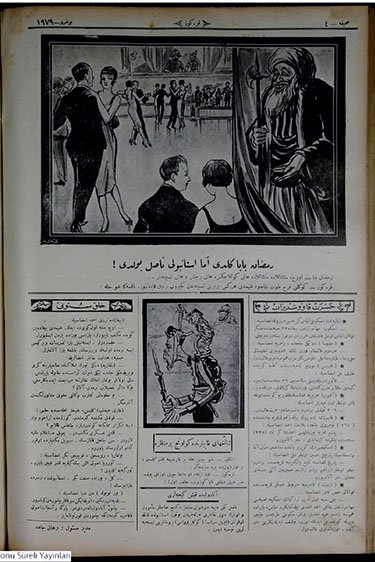66. Today in 1920s Turkey: 5 March 1927 (Father Ramadan Visits the 1920s and Finds People Dancing)

(Cartoon, Karagöz, 5 March 1927, no. 1979, page 4.)
Comments:
March 5 was the first day of the holy month of Ramadan in the year 1927. Fasting from dawn to dusk every day during the month of Ramadan is one of the Five Pillars of Islam and this ritual is widely practiced across the Islamic world. Since the Islamic Hijri calendar follows lunar cycles it is roughly 10 days shorter than the Gregorian calendar which is based on a 365-day solar year. This 10 day descrepancy is why Ramadan never falls on the same dates two consecutive years in a row the Western system of time keeping. For instance, ninety years later, in 2017 the month of Ramadan will begin on May 26.
Throughout Ramadan (or in Turkish, Ramazan) the faithful are expected to maintain virtuous thoughts and engage in pious behavior. After the sun sets and fasts are broken people are permitted to eat and be entertained. Thus, for iftar or the breaking of fasts special foods are prepared and much-anticipated entertainment programs arranged for the evenings. This magazine’s mascots were themselves adapted from the characters Karagöz and Hacivat who were originally part of a long standing tradition of Ramadan entertainment especially popular in urban centers. As the main characters of Turkish shadow theater, Karagöz and Hacivat appeared every night in local coffeehouses where they reenacted one of thirty semi-canonized adventures behind a screen illuminated with an oil lamp. Providing comic relief for the devotionally-exhausted masses, these plays often revolved around a ruse or confusion that fictitiously violated established social norms.
As is customary for this publication, Karagöz and Hacivat appear in the above cartoon. They are the two men located in the window in the background. The rest of the cartoon consists of ball room complete with dancing couples and an orchestra. Lurking behind a curtain in the foreground to the right is an old, bearded man holding an ax and dressed anachronistically in a robe, kamarband, turban, and baggy pants. The seemingly jovial man is the “Father Ramadan” mentioned in the text below the cartoon. To my knowledge, Father Ramadan is not a character that exists today in Ramadan-related folklore in Turkey. Therefore, he may have been a modern Turkish invention (or borrowed from a non-Turkish, Islamic tradition) introduced in the 1920s as Ramadan’s equivalent of Christmas’s Santa Claus. Alternately, Father Ramadan may simply represent a personification of traditional Ramadan located somewhere in a Medieval age (judging by his attire) unaffected by modern life.
Indeed, the cartoon’s text reveals that there is a tension between old traditions and new ones as they relate to the ever-evolving Ramadan “season.” Arriving seemingly from the past, and having landed in a dance hall on the first evening of the holy month, Father Ramadan asks where typical Ramadan treats such as sweet jams and güllaç are and where religious paraphernalia such as prayer beads have gone. Karagöz replies by adapting these “old fashioned” staples to the modern pastime of dancing and in doing so draws a contrast between the past and present. In the 1920s couples heat each other up on the dance floor rather than cooking up fruit jams and shuffle each others hearts around instead of counting prayer beads. This is most likely a humorous comparison rather than a serious critique of modernity since “letting loose” was always part of the post-Ramadan unwinding activities, and Karagöz, of all people would know this. Alternately (although, less likely), Karagöz could be a traditionalist when it comes to Ramadan in particular… If so, maybe his character sees dance halls as infringing upon the success of traditional forms of entertainment such as shadow plays. But if that were the case, I would have expected Father Ramadan to include that in the list of missing Ramadan attributes alongside prayer beads and jams.
In any case, reminiscing about how Ramadans have changed over the years is itself a common traditional Ramadan pastime popular among many people to this day. Karagöz makes sure to keep this particular tradition alive and thriving.
English:
Father Ramadan Has Come and Found Istanbul in What Condition!
Father Ramadan: Praise be, praise be, but where is your güllaç, where are the fruit jams, where are the prayer beads?
Karagöz: May your heart stay at ease my dear father, now everyone is shuffling one another like prayer beads and boiling each other like [they’re preparing] fruit jams. Just look at this situation!
Türkçe:
Ramazan Baba Geldi ama Istanbul’u Nasıl Buldu!
Ramazan Baba: Oh, maşallah, maşallah, hani güllacınız, hani reçeller, hani tespihler…
Karagöz: Gönlünü ferah tut babacığım, şimdi herkes birbirini tespihten geçirip reçel kaynatıyor. Baksana şu hale!

(Entire page, Karagöz, 5 March 1927, no. 1979, page 4.)